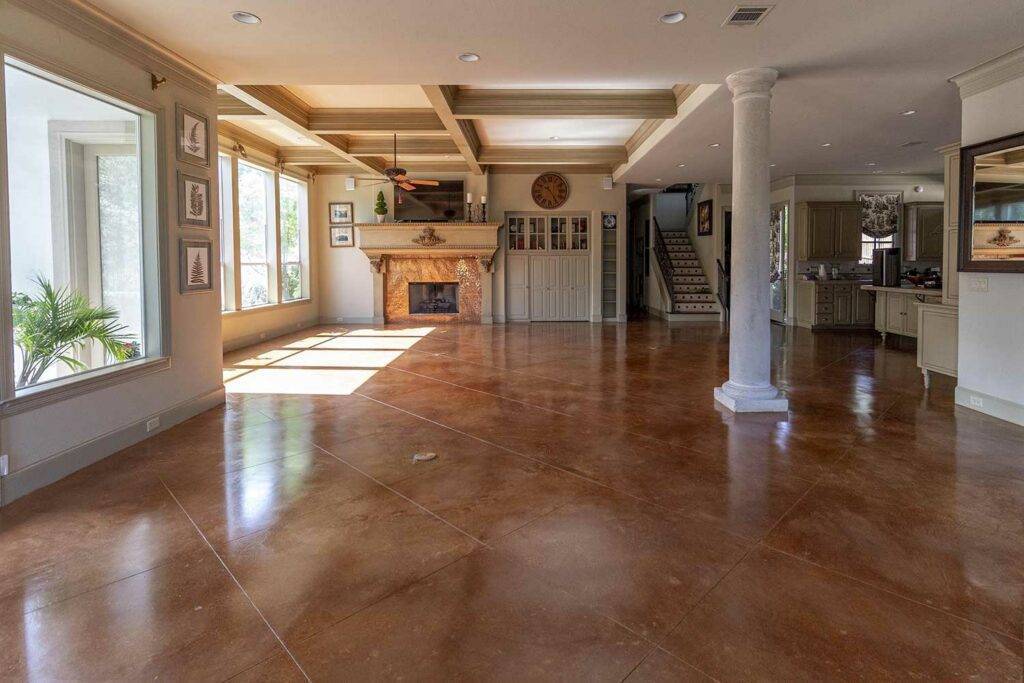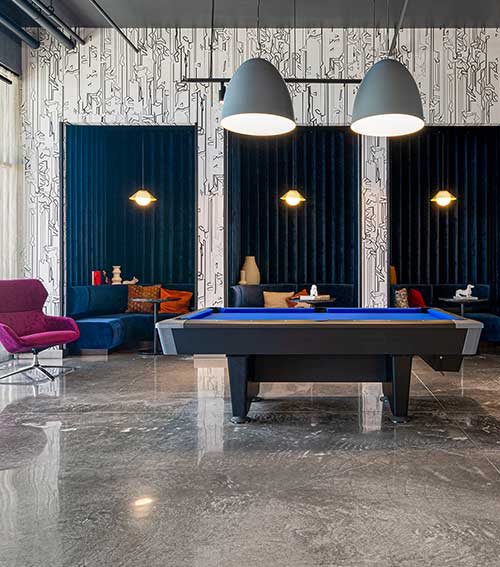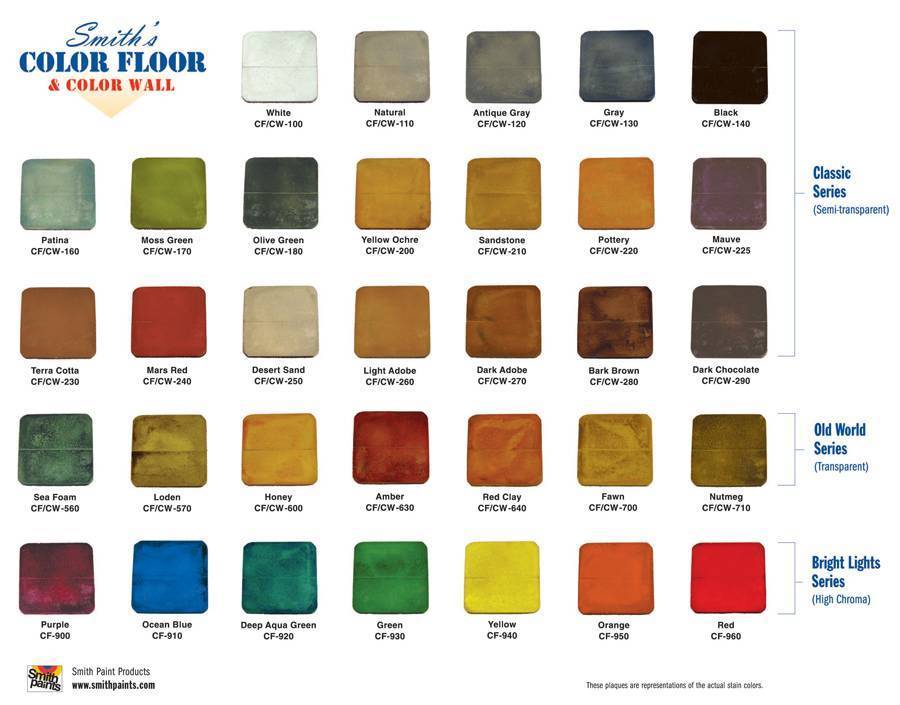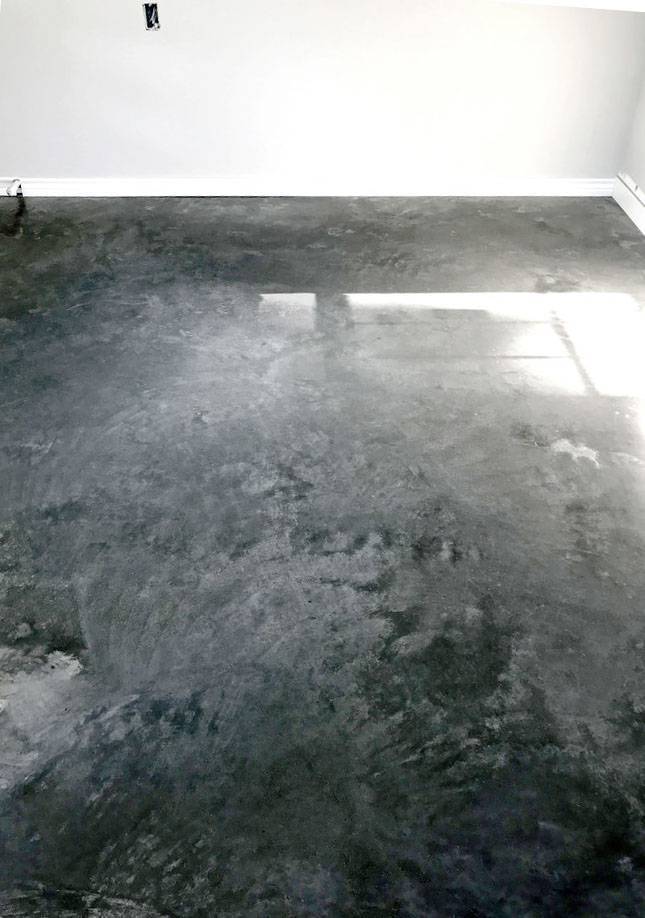Stained concrete is by far the most common type of concrete finish. This is due to stained concrete’s versatility.
Stained concrete can be installed on both freshly poured and existing slabs to achieve a wide variety of finishes, and is commonly used in both residential and commercial installations.
What is Stained Concrete?
While an oversimplification, stained concrete is a concrete slab that’s had some sort of color added to its surface. The complexity in this topic comes from the fact that there are several different categories of concrete colorants, each with ideal installation settings and different downsides and benefits.
Unlike paint or other concrete coatings, concrete stain penetrates the surface of concrete, leaving a finish that’s unlikely to chip or scratch. Like wood stains, most concrete stains are semi-translucent, allowing you to see the natural beauty and variation of the concrete surface through the stain color. A concrete stain can often be installed quickly and at a cost similar to or lower than most other flooring options.
Types of Concrete Stain
ACID STAIN
Acid stain is the oldest and most prevalent style of concrete stain. For most people, an acid stain is what they picture when thinking of a decorative concrete floor. Acid stain has been used for over 100 years and is ubiquitous in commercial and residential concrete flooring installs-especially for achieving brown concrete floors.
Acid stain is made from water, muriatic acid, and metallic salts. Acid stain chemically and permanently modifies the color of concrete by reacting with calcium in its surface. Metallic particles are permanently bonded to the calcium in the concrete, creating the stained concrete floors we’re used to seeing.
Acid stains are penetrating, creating a colored surface that’s completely resistant to ultra-violet light. Because of this, acid stain is the best concrete stain to use on an outdoor surface. Other styles of concrete stain may fade or discolor as they’re exposed to sunlight. Acid stains are so durable that they can be utilized in high-traffic areas without the risk of chipping or peeling.
Acid stain generally has a variegated or marbled appearance due to varying amounts of lime in the concrete surface. When installing darker stain colors, an acid stain can be very effective at covering up imperfections in concrete surfaces. For this reason, they’re often used in loft-style apartments or rustic commercial renovations where a concrete slab may be worn or many decades old.
The primary limitation of an acid stain is that it’s available in a limited variety of stain colors. These stain colors include earth tones, black, and light blues, and greens. Further, acid stains may need up to 24 hours to fully react with the concrete surface, which can be prohibitively long for some projects.
An acid-stained floor must be coated with a sealer to protect it from foot traffic. Solvent-based acrylic sealers are most commonly used in exterior applications, while water-based polyurethane sealers are best for interior installs.
For stained concrete inspiration and pictures, visit our ‘concrete stain colors‘ page


Luxury Polished Concrete Floors
Dallas | Fort Worth | Austin | Houston | San Antonio
Craftsman Concrete Floors provides innovative, eco-friendly concrete flooring services for both residential and commercial projects across Texas. Whether designing a new build or renovating an existing space, our experienced team is committed to delivering meticulous customer service and satisfaction, segment-leading expertise, and an equally stunning and sustainable finished product.
WATER-BASED CONCRETE STAIN
Water-based concrete stains are a newer style of concrete stain and work by depositing fine pigments onto concrete surfaces. Unlike acid stains, they’re available in a full spectrum of colors. Further, as they don’t react with the concrete surface as acid based stains do, water-based stains can offer color with a very uniform appearance. Because of this, they can be used to create intricate designs or even add a corporate logo to a concrete floor. Due to their potential for opacity, water-based concrete stains are the best-suited stain option for creating consistent, solid color stained concrete floors.
While they’re considered UV stable, they’re less durable than acid stains and are less frequently used on outdoor concrete.
When utilizing a water-based concrete stain, it’s important that they’re always coated with a high-quality concrete sealer. Stained concrete sealers should be periodically inspected and re-applied when needed to prevent stained concrete floor failure in high traffic areas.
Another benefit of water-based concrete stains is that they have no odors or VOCs and dry quickly. This can be a huge benefit for live-in residential renovations or overnight stained concrete floor touch-ups in retail installations. Below is a standard water-based stain color chart.

CONCRETE DYE
Concrete dyes are a type of concrete stain made from ultra-fine pigments suspended in solvents. Unlike an acid concrete stain, they’re not reactive to the concrete surface. They offer the most transparency and natural appearance of any concrete stain and are mainly used for tinting polished concrete or concrete overlays.
Solvent-based concrete dyes are very uniform in their stain color but require very skilled installers as their short dry time leaves little room for error. Concrete dyes are not UV stable and therefore cannot be used for outdoor installations. Concrete dye, however, can add a very natural-looking hint of color to interior concrete floors and is available in a wide variety of stain colors.
For more information about dyed concrete floors, visit our ‘polished concrete floor finishes‘ page
INTEGRAL CONCRETE COLOR
Although not technically a concrete stain, integral color is pigment added directly to a concrete mix before it’s poured. While this technique can only be utilized in new construction, it provides benefits that are not possible with a traditional concrete stain.
The main advantage of integral concrete color is that it’s homogeneous throughout the entire slab. This means that as a floor wears and ages the color will stay consistent. Further, all of the variations in the surface of the concrete are still visible, providing a modern appearance that rivals natural stone floors.
Another benefit of integral color is that it’s UV stable, so it’s especially well suited for outdoor stained concrete floor installations such as patios and skim work. The integral pigment does not require a sealer to prevent fading, so it’s generally the best option for surfaces, such as pool decks, that would become slippery when wet if sealed.
The main drawback of integral pigment, other than the fact that it can’t be installed on existing concrete, is that it can increase the cost of a concrete pour by as much as 20%. However, depending on the project, this cost may be offset by the fact that there’s no additional labor expense to install stain after the concrete is poured.

Another Consideration — Surface Preparation
While many DIY capable homeowners consider installing stained concrete floors themselves, proper surface preparation of concrete is important, especially on older slabs.
For acid and water-based stains, new construction may be prepped with a swing buffer prior to staining, but older slabs will likely require a planetary concrete grinder.
Acetone-borne concrete dyes should only be used on professionally polished concrete floors. Because of dust control and flammability issues, this installation should be avoided by DIY’ers.
looking to polish Concrete yourself? We have a diy polished concrete floor guide.
Looking for more Information About Stained Concrete Floors?
Our primary stained concrete page has resources and galleries to help you learn more about stained concrete floors. As always, give us a call for a free consultation.
